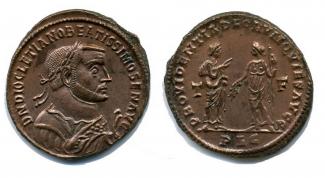Coin hoard, Roman, coin, bronze, found at Preshaw Park, Mill Barrows, Beauworth, Hampshire, issued by Constantine, Maximianus, Constantius, Severus, Probus, Diocletian, circa 280 to 309.
Preshaw Park Hoard, found with a pot at Mill Barrows, at the NW corner of Preshaw Park, Beauworth, Hampshire. The coins are in excellent condition and were probably never circulated.
Preshaw Park Hoard, found with a pot at Mill Barrows, at the NW corner of Preshaw Park, Beauworth, Hampshire. The coins are in excellent condition and were probably never circulated.
'Follis' of the emperor Diocletian
Roman, AD280-309
From a hoard found at Preshaw Park, Beauworth, Hampshire
Around the year AD294 there was a general coinage reform, which saw the first issue of a large bronze coin known as a 'follis'. Unfortunately it was given a value far above its true worth for it contained only 5% silver and was issued with a silvery coating. Soon after AD300 the standard of the coinage began to fall and a long decline set in. 'Folles' were struck at a variety of mints - London, Trier and later Arles and Lyon in southern France. Each mint marked its products with a characteristic mint-mark, for example, PTR is the mark for Trier: P(rima officina) - denoting the division of the mint - and TR(ier).



